Capturing Carbon
Air Date: Week of September 7, 2007
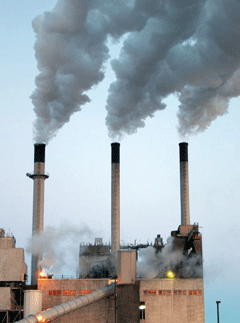
(Photo: Phillip J. Redman, U.S. Geological Survey)
Will new technology allow us to keep coal power from warming the planet with its greenhouse gas emissions? Living on Earth's Jeff Young visits two very different coal-powered plants to feel the burn.
Transcript
CURWOOD: From the Jennifer and Ted Stanley Studios in Somerville, Massachusetts - this is an encore edition of Living on Earth. I’m Steve Curwood.
Some call it a “coal rush.” Despite growing concerns about clean air and climate change, electric utility companies are pushing for a new fleet of coal-fired power plants in the U.S. Coal is a plentiful domestic source of energy, but all those new power plants could bring a spike in carbon dioxide pollution—a chief culprit in global warming. So scientists are looking for new ways to use this old fuel. One promising approach is called “carbon capture and sequestration.” It would take the CO2 out of power plant emissions and store it deep in the earth. Living on Earth’s Jeff Young looks at how coal might be made more climate friendly. The story is part of our occasional series, “Generating controversy: the changing climate of coal.”
YOUNG: Walking into the Dominion power station at Mount Storm, West Virginia, feels like entering the belly of the beast.
WOOD: Alright put your ear plugs in.
[ROAR OF MACHINERY]
YOUNG: Massive grimy machines feed 15 thousand tons of coal a day to giant boilers. Plant manager Bill Wood shouts above the roar of pure, raw power.
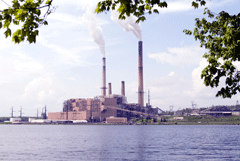
Dominion's Mt. Storm Power Station (Courtesy of Dominion)
YOUNG: Pulverized coal burners like this one dominate the power industry today. This old workhorse powers almost a million homes and has done so for 40 years.
[PASSING THROUGH DOOR PEOPLE GREETING]
YOUNG: In the control room we take out the earplugs and Wood points to a throbbing yellow glow on a monitor screen.
WOOD: When you’re talking about the boilers. We’ve actually got furnace cameras showing the fireball inside the boilers.
YOUNG: Wow, look at that. Man it’s like looking at the sun or something!
WOOD: It’s pretty intense. That fireball at it’s hottest point is probably in the neighborhood of 2,700 degrees Fahrenheit
YOUNG: You’re kind of looking straight into the heart of what your whole industry’s all about, right there.
WOOD: That’s right. We generate steam.
YOUNG: They also generate a lot of carbon dioxide, the main greenhouse gas. A power plant this size can pump out more than six million tons of CO2 a year. There are ways to teach old dogs like Mount Storm the new trick of fetching CO2. One method binds up carbon in the exhaust with ammonia. Another sends pure oxygen into the boiler. Both would likely be very costly, raising the price of electricity as much as 50 percent. Climate scientists say building a whole new fleet of these old style power plants without any carbon capture technology could be a climate disaster. Princeton University professor Robert Socolow compares it to trains on a collision course.
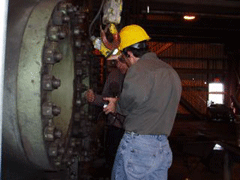
(Courtesy of Jeff Young)
SOCOLOW: Train number one is the rush to coal power; train number two is the urgency of dealing with climate change. The switch is carbon capture and sequestration, or CCS.
YOUNG: Socolow told a congressional committee that carbon capture and sequestration technology is urgently needed and ready for full-scale deployment. After the hearing Socolow told me that one form of carbon capture stands out from the rest.
SOCOLOW: The surest way to move forward is to build IGCC plants that seems, by general agreement, to be what we can do today and will be the cheapest route.
YOUNG: IGCC is a cleaner kind of coal power that could provide an easier way to remove carbon dioxide. To understand how, we first need to know what IGCC is: integrated gasification combined cycle. That’s quite a mouthful. But the part to focus on is the “G” —the gasification. That is the key difference.
HORNICK: We don’t burn coal, in terms of combusting it, which is the normal way of doing it, we gasify coal.
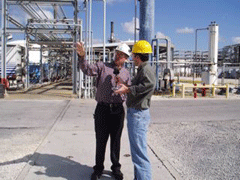
Jeff Young gets the tour of Tampa Electric's Polk Power Station from Plant Manager Mark Hornick.(Courtesy of Jeff Young)
HORNICK: We actually turn that solid fuel into a gaseous fuel before we use it in combustion turbines. And that’s what the gasification is all about.
YOUNG: The IGCC plant is a totally different animal from the old pulverized coal burner at Mount Storm. There’s no plume from a smokestack, no boiler with a glowing fireball. Gasification begins when a coal slurry is injected with oxygen into a high-pressure environment to create a gas. A turbine burns it to make power. But before that, pollutants like sulfur and particulates are stripped from the pressurized gas, and that’s much easier than dealing with the exhaust from a boiler. Hornick says that same method could be used to strip out CO2 as well.
HORNICK: Well it wouldn’t be small deal. But it’s certainly something that’s doable and proven in IGCC. If you’re gonna do CO2 removal from any plant it is gonna increase cost. For IGCC they estimate about a 25% increase, which is not insignificant. However if you look at conventional coal it would be over 50% and technology is a lot less proven.
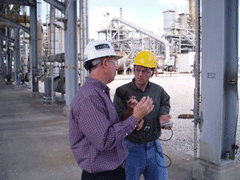
(Courtesy of Jeff Young)
IGCC plant to do it in three or four years—that’s remarkably fast in the world of power plants. And once captured the CO2 has to go somewhere. In some places it’s used to force oil and gas from old wells. It can also be pumped deep into formations in the earth where high pressure makes it a liquid. Small scale tests show the liquid CO2 stays underground.
A new study by MIT called “The Future of Coal” found most parts of the country could store large amounts of CO2. MIT chemistry professor John Deutch praises IGCC as a clean option for coal power but does not declare it the technological winner. Deutch served in both the US Department of Energy and CIA. He advocates much more research and development for all kinds of carbon capture and sequestration. He says current government spending doesn’t come close.
DEUTCH: We think that’s an urgent, urgent program for the Department of Energy to undertake, in this country, and for other countries to undertake around the world.

(Photo: Phillip J. Redman, U.S. Geological Survey)
MARKEY: You know, Saint Augustine used to say, “Oh lord make me chaste but not just yet.” These utility executives are saying, “Oh lord make me carbon free but not just yet.”
YOUNG: Markey leads a new special congressional committee on global warming and he’s pushing for a law to regulate greenhouse gas emissions. Without that, he says, it’s doubtful companies would pay to take the carbon out of coal.
For Living on Earth I’m Jeff Young in Washington D.C.
Links
To view MIT’s study “The Future of Coal," click here
Living on Earth wants to hear from you!
Living on Earth
62 Calef Highway, Suite 212
Lee, NH 03861
Telephone: 617-287-4121
E-mail: comments@loe.org
Newsletter [Click here]
Donate to Living on Earth!
Living on Earth is an independent media program and relies entirely on contributions from listeners and institutions supporting public service. Please donate now to preserve an independent environmental voice.
NewsletterLiving on Earth offers a weekly delivery of the show's rundown to your mailbox. Sign up for our newsletter today!
 Sailors For The Sea: Be the change you want to sea.
Sailors For The Sea: Be the change you want to sea.
 The Grantham Foundation for the Protection of the Environment: Committed to protecting and improving the health of the global environment.
The Grantham Foundation for the Protection of the Environment: Committed to protecting and improving the health of the global environment.
 Contribute to Living on Earth and receive, as our gift to you, an archival print of one of Mark Seth Lender's extraordinary wildlife photographs. Follow the link to see Mark's current collection of photographs.
Contribute to Living on Earth and receive, as our gift to you, an archival print of one of Mark Seth Lender's extraordinary wildlife photographs. Follow the link to see Mark's current collection of photographs.
 Buy a signed copy of Mark Seth Lender's book Smeagull the Seagull & support Living on Earth
Buy a signed copy of Mark Seth Lender's book Smeagull the Seagull & support Living on Earth

